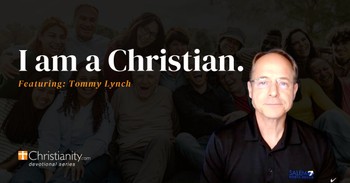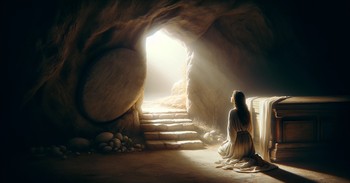Here are ten of the most popular and important Bible stories for kids to learn about God and Jesus. Use these stories as an introduction to the Bible for children, starting with Earth's creation to Jesus's resurrection!
Bible Stories for Children
Click on the Bible stories below to jump right to that biblical account.
- God Created Adam and Eve
- Noah and the Ark
- Joshua and the Battle of Jericho
- David and Goliath
- Fiery Furnace: Shadrach, Meschach, and Abednego
- Daniel in the Lion’s Den
- Jonah and the Whale
- Birth of Christ
- Jesus Feeds 5000
- Crucifixion and Resurrection of Christ
God’s Creation: Adam and Eve
God created the first man, Adam, and then Eve, the first woman. God put Adam and Eve in the Garden of Eden to care for and nurture the land. He told Adam and Eve that they could eat any fruit from the trees except for the tree of good and evil. God warned them that they would die if they ate from the tree.
One day, Satan came disguised as a snake and spoke to Eve, convincing her to eat the fruit from the tree of good and evil. Eve told the serpent that God said they should not eat it and they would die if they did, but Satan tempted Eve to eat, saying that she would become like God if she did. Eve believed the lie and took a bite of the fruit. She then gave some to Adam for him to eat. Adam and Eve, now knowing that they had sinned, immediately felt ashamed and tried to hide from God.
Read more about the story of Adam and Eve, their lives in the Garden of Eden, how sin entered the world, and the consequences of disobeying God in Genesis 1-3.
Noah and the Ark
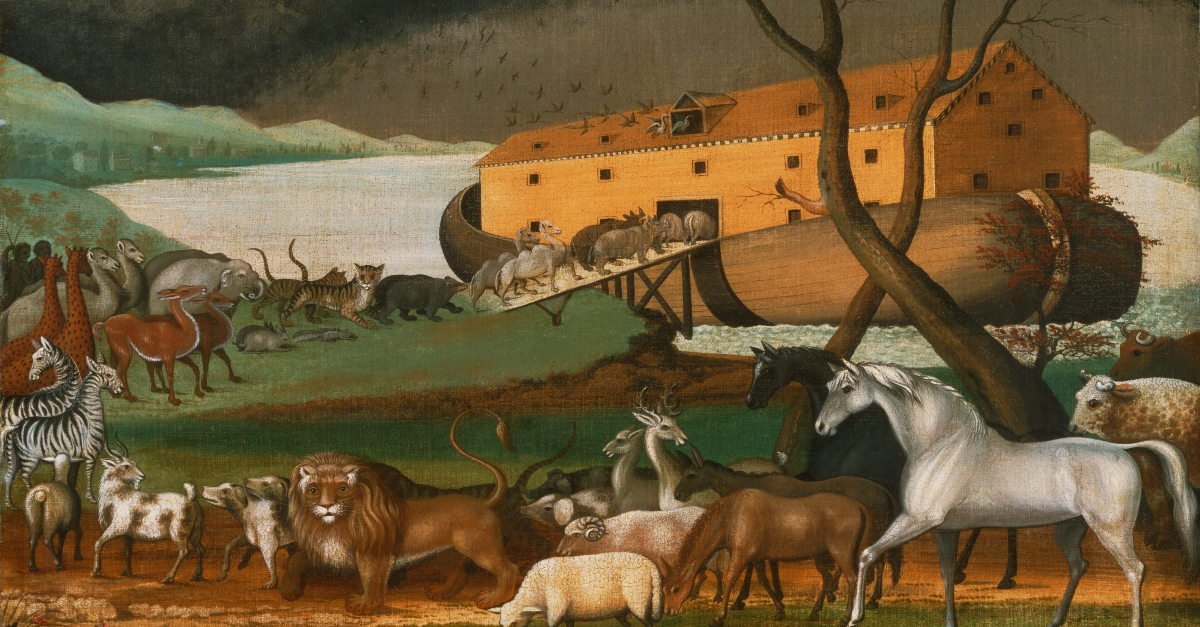
The story of Noah's Ark is one filled with faith, perseverance, and promise. Noah was a man who found great favor in God's eyes. The entire population of mankind had become evil and wicked, and God decided to bring a flood to the earth to destroy everyone but Noah and his family. God told Noah to prepare an ark big enough to hold one male and one female from every kind of animal and creature. This is why many pictures depicting Noah's ark show animals coming two by two.
When it started raining, Noah brought his wife and his sons, Shem, Ham, and Japheth, and their wives onto the ark. It rained for 40 days and 40 nights. After coming to rest on a mountain, Noah sent out a dove to find dry land but it returned. Seven days later, he sent out another dove, which returned with an olive leaf, signaling that it was safe to go onto land.
God promised never to destroy the earth with a flood again, and He placed a rainbow in the sky as a sign of his promise.
Joshua and the Battle of Jericho
Scouts from the Israelites crept into the walled city of Jericho and hid at the house of Rahab, who was noted as a prostitute. Rahab had faith in God and informed the Israelites of Jericho's fear, saying, "I know that the Lord has given you this land and that a great fear of you has fallen on us so that all who live in this country are melting in fear because of you."
She helped the scouts hide from the king's soldiers, then left out a window since her house was located next to the city wall. Rahab demanded the spies affirm an oath as she swore not to give their plans away, and congruently, they vowed to spare Rahab and her family when the battle of Jericho occurred. She was to fasten a scarlet rope in her window to symbolize their protection.
God instructed Joshua with an unusual strategy for the battle of Jericho. He told Joshua to have his army march around the city once a day for six straight days. While marching, the soldiers played their trumpets as the priests carried the Ark of the Covenant around the city of Jericho.
On the seventh day, the Israelites marched around the walls of Jericho seven times. Joshua assured them that by God's order, everyone in the city must be slain except Rahab and her family. All silver, gold, bronze, and iron items were to go into the Lord's depository.
The men yelled a powerful roar at Joshua's order, and Jericho's walls miraculously fell. The Israelite army raced in quickly, conquering the city, and, as promised, only Rahab and her family were spared.
David and Goliath
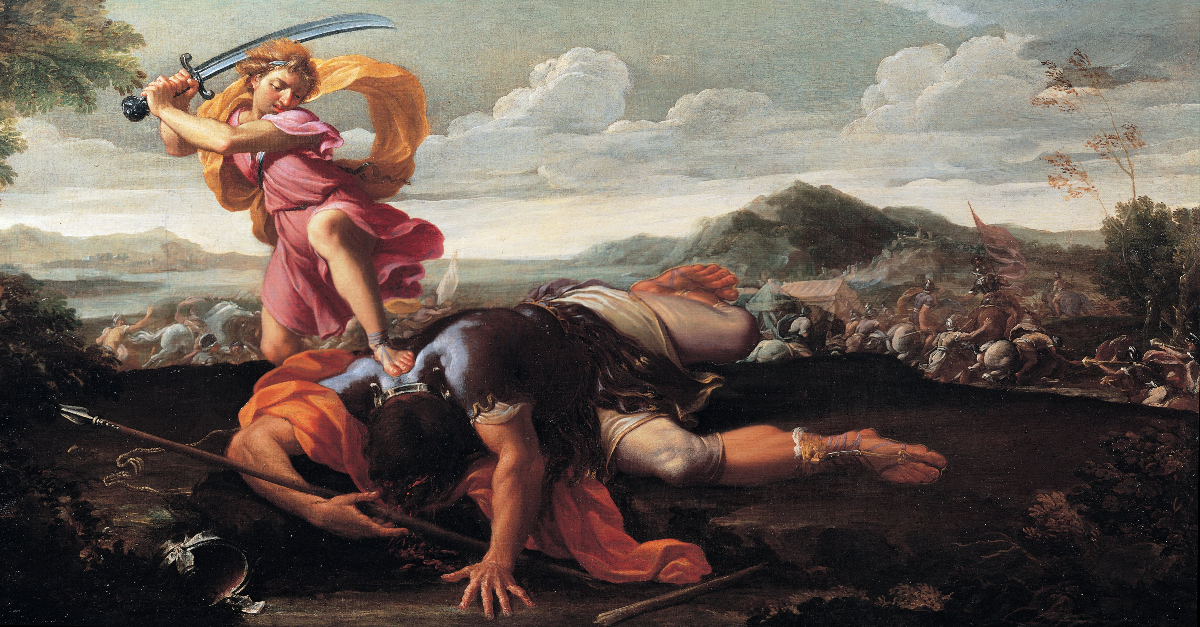
David was the youngest of Jesse's twelve sons. One day, the nation of Israel was called to fight the Philistine army that had gathered for war. While David's brothers went to fight, young David stayed back. The two armies gathered to stand on opposite sides of a deep valley. A great Philistine giant named Goliath, who stood at over nine feet tall, came to the front of the Philistine battle line each day for forty days and mocked the Israelites and their God. Goliath called them to fight, but King Saul and the Israelites were scared and did nothing.
David was sent by his dad Jesse to visit the front lines and bring back battle news from his brothers. David heard Goliath mocking Israel and their God. David was brave and volunteered to fight Goliath. He persuaded King Saul to let him go fight and decided not to wear any of King Saul's armor. David carried his sling and gathered five smooth stones. Goliath laughed at David but David responded that even though Goliath had a sword and spear, he came in the name of the Lord Almighty, the God of Israel. David put a rock in his sling and swung one of the rocks at Goliath's head. The rock sank into the giant's forehead and he fell. David then picked up Goliath's sword and used it to kill Goliath and cut off his head.
The Philistines turned and ran when they saw their giant hero killed. Israel had won the battle because of a boy who had faith and trusted God! Read the full Bible story of David and Goliath in the Scripture below and find further study help and summaries for this wonderful account of faith and God's provision!
Fiery Furnace: Shadrach, Meschach, and Abednego
The story of Shadrach, Meschach, and Abednego from the Bible book of Daniel 6 tells us of three Jewish boys who refused to bow down to the King of Babylon, King Nebuchadnezzar.
The three men grew wise and respected as highly appointed officials in Babylon. Other Babylonian officials who were jealous of the Shadrach, Meschach, and Abednego were able to get King Nebuchadnezzar to command that all people bow down to a golden statue. When the three men refused to bow down and worship the idol and god of Babylon, King Nebuchadnezzar had them thrown into the fiery furnace which was heated seven times hotter than normal. Shadrach, Meschach, and Abednego had faith that God would save them. When King Nebuchadnezzar looked into the fire he saw four men walking around in the furnace unharmed - Shadrach, Meschach and Abednego, and the Son of God. King Nebuchadnezzar brought the young men out of the flames, promoted them to a higher office, and decreed that the God of Israel be worshipped.
Daniel in the Lion’s Den
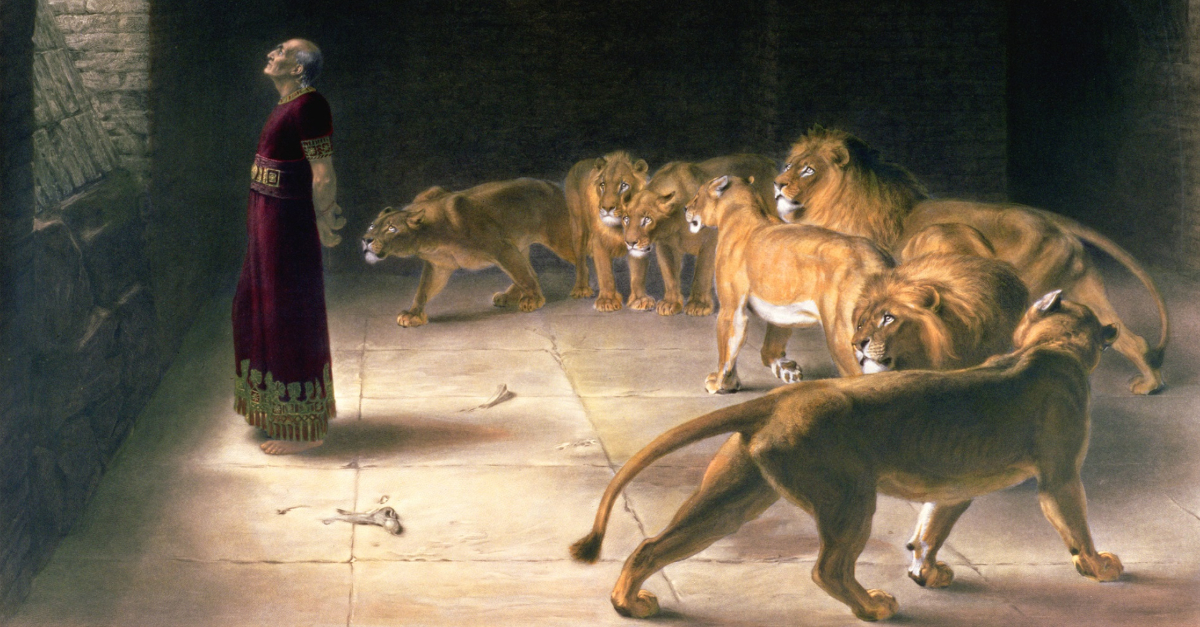
The story of Daniel in the lion's den teaches us about the promises and faithfulness of God, even if we feel like everything has been lost. This is a summary of the Biblical account of Daniel's refusal to bow to man and how God used Daniel to save a nation. You can read more in-depth Bible verses from the Scripture below and use the articles and videos to understand the meaning behind this teachable event in the Bible.
King Darius was ruler over Babylon and had appointed several men to help him govern and lead. Daniel, the leader of advisors, was a man who believed in God and followed the Lord's commands. The other men did not like Daniel and did not want him in charge, so they devised a way to get rid of Daniel.
These men knew that Daniel served the God of Israel. They told King Darius to make a new law in which people could worship and pray to only the king and if they worshipped or prayed to other gods, they would be thrown into the lions' den. The starving lions would eat and kill the lawbreaker.
Daniel understood the new law of Darius but committed in his heart to remain steadfast in his prayer and praise to the Lord. Daniel prayed three times a day with his windows open. When the men saw Daniel and brought accusations against him to King Darius, the king was devastated because he favored Daniel. The king knew he could not change the law and Daniel was thrown into the lion's den.
Jonah and the Whale
God called to Jonah one day and told him to go preach to Nineveh because the people were very wicked. Jonah hated this idea because Nineveh was one of Israel's greatest enemies and Jonah wanted nothing to do with preaching to them!
Jonah tried to run away from God in the opposite direction of Nineveh and headed by boat to Tarshish. God sent a great storm upon the ship and the men decided Jonah was to blame so they threw him overboard. As soon as they tossed Jonah in the water, the storm stopped.
God sent a big fish, some call it a whale, to swallow Jonah and to save him from drowning. While in the belly of the big fish (whale), Jonah prayed to God for help, repented, and praised God. For three days Jonah sat in the belly of the fish. Then, God had the big fish throw up Jonah onto the shores of Nineveh.
Jonah preached to Nineveh and warned them to repent before the city is destroyed in 40 days. The people believed Jonah, turned from their wickedness, and God had mercy on them. Jonah now became angry and bitter because God did not destroy the Ninevites who were Israel's enemy! When Jonah sat to rest God provided a vine to give him shade. The next day, God sent a worm to eat the vine. Jonah now sat in the hot sun complaining and wanting to die. God called out to Jonah and scolded him for being so concerned and worried about just a plant while God was concerned with the heart condition and lives of 120,000 people who lived in the city of Nineveh.
Birth of Christ
Almost 2,000 years ago a young woman from the town of Nazareth named Mary was visited by an angel named Gabriel. Gabriel told the Jewish woman that she would have a son named Jesus and that he would be the Son of God. At this time, Mary was engaged to her soon-to-be husband Joseph. When told Joseph he was hurt and confused because he did not believe Mary. The angel Gabriel visited Joseph and told him that Mary would be pregnant from the Lord and that she would have a son named Jesus who would save the people from their sins.
Mary and Joseph had to travel to Bethlehem because of an order from the Roman emperor that a census, or record, of all people, be taken in their hometown. After traveling pregnant on a donkey for several days, Mary and Joseph arrived in Bethlehem and were told that there were no places to stay. The inns were full. Seeing that Mary was due at any moment, an owner of an inn told Joseph that they could stay in his stable.
Mary and Joseph settled down on the hay in a stable with animals sleeping. Mary went into labor and Jesus was born in the stable. The only place for the sleeping baby to rest was most likely in the animals' trough, known as the manger.
During this time, an angel appeared to shepherds who were watching their flocks in the fields near Bethlehem. The angel told them the good news of the birth of the Savior and Messiah, Jesus Christ. The shepherds immediately went to find baby Jesus, which the angels told them they would find sleeping in the manger.
After some time, three wise men, also known as magi, saw the brilliant star in that sky that rested over where Jesus was born. The three wise men traveled from afar eastern country to find the new king. During the wise men's' trip, Herod the king of Judah met with the wise men and told them to come back and let him know where the baby king was so that he could go worship him as well. The wise men continued to Bethlehem and found Jesus right where the star pointed. They knelt and worshipped the Savior and gave him gifts of gold, frankincense, and myrrh. They then traveled back home in a different way knowing that King Herod was not intending to worship Jesus but that he planned to kill the baby.
We celebrate the birth of Jesus and the coming of our Savior at Christmas time. Read the full Scripture passages for the accounts of Jesus' birth in the Bible books of Luke and Matthew.
Jesus Feeds 5000
Matthew 14:13-21; Mark 6:31-44; Luke 9:10-17; John 6:5-15
Sometimes God uses the unexpected to open our eyes to His power. In the Bible story of Jesus feeding the 5,000, we see the doubt of Jesus’s disciples and the provision of God through a miracle. The Scripture below details the account of how five loaves of bread and two fish became enough to feed 5,000 with leftovers!
If you’re in a situation that needs a miracle, give God room to work through ways you never imagined or dreamed. Sometimes the miracle is not what we expect, but God knows what we need!
In Matthew 14, the Bible says, "When Jesus landed and saw a large crowd, he had compassion on them and healed their sick. As evening approached, the disciples came to him and said, “This is a remote place, and it’s already getting late. Send the crowds away, so they can go to the villages and buy themselves some food.” Jesus replied, “They do not need to go away. You give them something to eat.” “We have here only five loaves of bread and two fish,” they answered. “Bring them here to me,” he said. And he directed the people to sit down on the grass. Taking the five loaves and the two fish and looking up to heaven, he gave thanks and broke the loaves. Then he gave them to the disciples, and the disciples gave them to the people. They all ate and were satisfied, and the disciples picked up twelve basketfuls of broken pieces that were leftover. The number of those who ate was about five thousand men, besides women and children."
Crucifixion and Resurrection of Christ
Matthew 27-28; Mark 15-16; Luke 23-24; John 19-20
The Crucifixion of Jesus - Matthew 27, Mark 15, Luke 13, John 19
The crucifixion of Jesus is recorded in the New Testament books, known as the Gospels - Matthew, Mark, Luke, and John. This Bible story is the central summary of the saving Gospel of Jesus. Jesus had prophesied of his death in Matthew: "from that time on Jesus began to explain to his disciples that he must go to Jerusalem and suffer many things at the hands of the elders, the chief priests and the teachers of the law and that he must be killed and on the third day be raised to life." Jesus understood that his life would be required as a sacrifice for the sins of man.
At the height of his ministry and miracles, many Jews came to believe in Jesus as the Messiah, the Son of God. Jewish leaders feared Jesus because of his growing followers. With the help of Judas Iscariot, Roman soldiers arrested Jesus and he was put on trial for claiming to be the king of the Jews. According to Roman law, the punishment for rebellion against the king was death by crucifixion.
The Roman governor Pontius Pilate was reluctant when it came to the punishment for Jesus. Pilate could find no wrong in Jesus, yet he wanted to give the people what they wanted, and that was the death of Jesus. Pilate washed his hands in front of the crowd to symbolize that he was not taking responsibility for the bloodshed of Jesus and then handed Jesus over to be beaten and lashed. Jesus had a crown of thorns thrust on his head and made to carry his cross along the pathway to the hill where he would be crucified. The location of Jesus' crucifixion is known as Calvary, which is translated from "a place of the skull".
Crowds had gathered to mourn and watch Jesus' death. Jesus was nailed to the cross between two criminals and his sides were pierced by a sword. While Jesus was mocked, one of the criminals asked Jesus to remember him and Jesus responded: "Truly I tell you, today you will be with me in paradise." Jesus then looked to heaven and asked God to "forgive them, for they do not know what they do." When taking his last breath, Jesus spoke: "Father, into your hands I commit my spirit...it is finished."
Extraordinary events marked the death of Jesus. The sky was completely dark for three hours as Jesus hung on the cross. At the moment of his last breath, the earth shook, the temple curtain split from top to bottom, and the tombs of saints opened and their bodies raised from the dead.
The crucifixion of Jesus was a part of God's plan from the very beginning of the birth of Jesus. The sin of mankind would require a sacrifice. The sinless life of Jesus was lived and given so that man could receive salvation and eternal life in heaven.
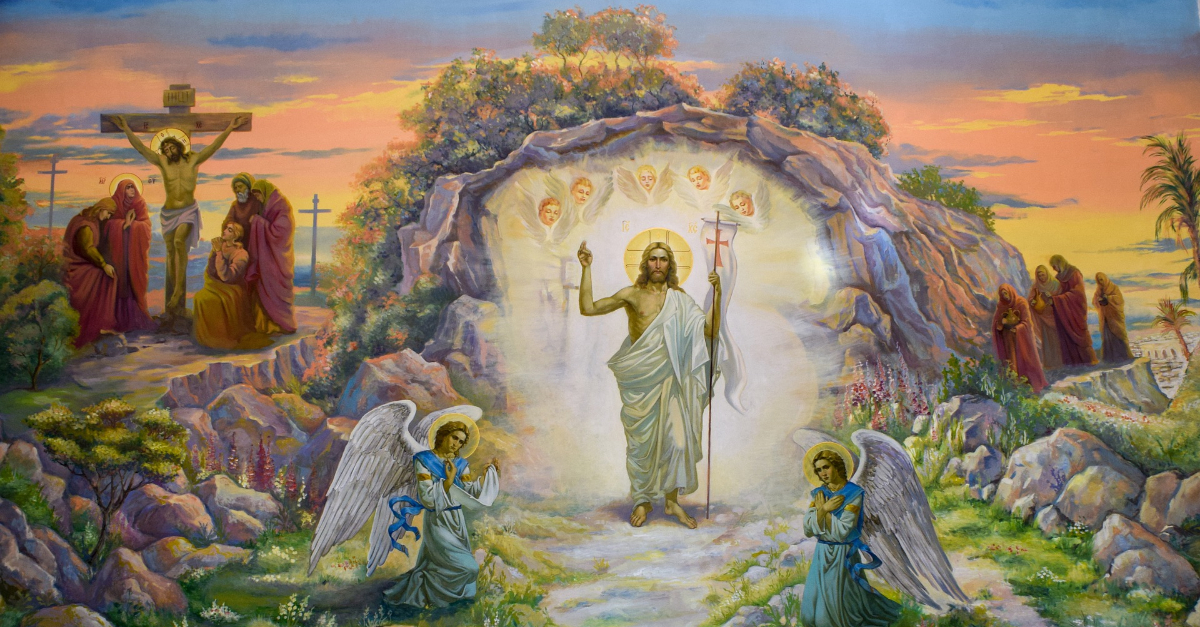
The Resurrection of Jesus - Matthew 28, Mark 16, Luke 24, John 20
The resurrection of Jesus Christ is the foundation of the Christian faith. Without the resurrection, the belief in God's saving grace through Jesus is destroyed. When Jesus rose from the dead, he confirmed his identity as the Son of God and his work of atonement, redemption, reconciliation, and salvation. The resurrection was a real, literal, physical raising of Jesus’ body from the dead.
Jesus was arrested, tried, and found guilty of claiming to be a king. His body was hung on a cross between two thieves. After his death, Jesus’ body was wrapped in linen cloths and placed in a tomb with a large stone rolled across the opening. On the third day, an early Sunday morning, Mary Magdalene and another Mary came to the tomb and found it empty. Sitting on the rolled-away stone was an angel of the Lord who told them to not be afraid because Jesus had risen. As the women left to tell the disciples, Jesus Christ met them and showed them his nail-pierced hands.
Both the Old and the New Testament speak of the truth of Jesus being raised from death - Jesus testified of his resurrection before he died on the cross and his disciples witnessed his body after the resurrection
Christianity.com's editorial staff is a team of writers with a background in the Christian faith and writing experience. We work to create relevant, inspiring content for our audience and update timely articles as necessary.


